13 Fish You Should Never Eat + 3 Better Seafood Options
Fish is good for you, right? Not so fast… Let’s talk about 13 fish you should never eat (some will surprise you), and follow it up with 3 better seafood options!
Some fish are full of omega-3 fatty acids, which are essential for brain development and health.
Unfortunately, our oceans aren’t very healthy these days.
Because fish filter seawater through their systems, toxins in the water can end up in your body.
In addition, the fishing industry follows some practices that aren’t great for your health or the environment, including overfishing and fish farming.
This post may contain affiliate links, which helps keep this content free. Please read our disclosure for more info.
What’s Wrong with Farmed Fish?
According to the World Wildlife Fund, farmed seafood disturbs the natural ecosystem of the ocean. Chemicals are used to maintain an ideal environment for the farm, but that’s not the ideal environment for ocean life sustainability.
Why do they use chemicals? To quell the diseases and parasites that can run rampant in an overcrowded fish farm.
If farmed fish escape, they can breed with wild fish, permanently altering the species. The abundance of feed and fish waste in the waters also crowds out the oxygen that other aquatic wildlife needs to survive.
Much of the feed used in farms is inexpensive and corn-based. This throws off the ratio of omega-3s to omega-6s in the fish, making them less healthy for human consumption.
1. Farmed Tilapia
Some people claim that eating this popular fish is worse for your health than eating bacon. (However, just to get one thing clear, bacon isn’t the devil when eaten in moderation and from good sources).
The problem with tilapia is that it is highly farmed. You’re unlikely to be eating wild-caught tilapia.
Researchers at Wake Forest have discovered that farm-raised tilapia contains ratios of fatty acids that are actually damaging to your health (1).
Farmed tilapia contains high levels of omega-6 fatty acids and low levels of omega-3s. This actually contributes to inflammation instead of reducing it.
If you’re trying to follow the medical community’s recommendation to eat more fish, you’re not really improving your health by eating more tilapia.
2. Atlantic Salmon
If you search for a fish recipe online, you’ll come up with thousands of delicious-looking options for salmon dishes. However, this common fish is not so great to eat.
Most Atlantic salmon comes from farms. You won’t see wild Atlantic salmon, because it’s actually an endangered species, explains NOAA Fisheries.
The abundance of Atlantic salmon farms is one of the reasons the wild species is endangered to begin with.
The omega-3 levels in Atlantic salmon are 50% lower than they were five years ago, says a 2016 study (2). Because the anchovy population is dwindling, less of that fish is used to feed the salmon, throwing off the fatty acid ratios.
Because farmed salmon don’t get the right nutrients to develop properly, they don’t always get that rosy glow so characteristic of this type of fish. Therefore, many fish farmers add a synthetic pigment to the feed.
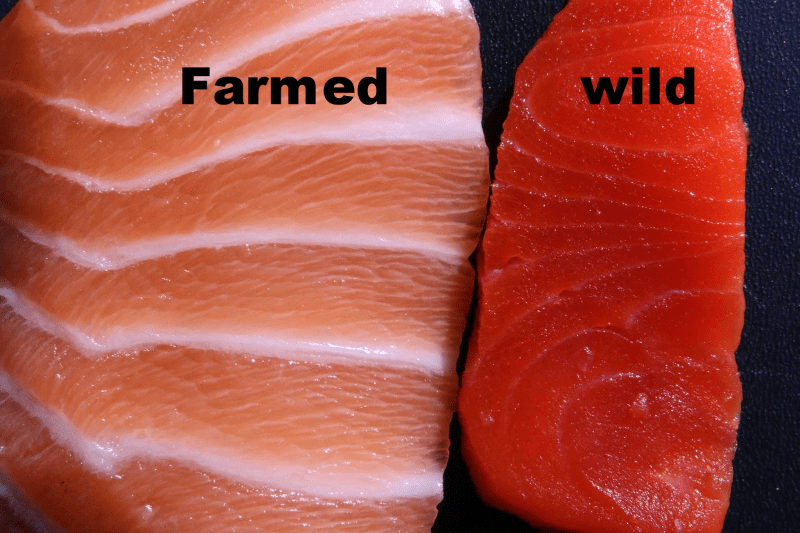
This about this, y’all… Our watermelons are genetically modified to not contain seeds (the NATURAL way that the fruit reproduces), and farm-raised salmon has pigment ADDED just to make you feel better about eating it.
Can you see the problem here? I know it can be tough to afford the good stuff, but demand drives prices down!
According to Clean Plates, the health effects of this chemical are questionable.
Dioxins, chemicals that are stored in the fish’s fat cells, are found at levels more than 10 times higher in farmed salmon than wild-caught salmon. According to the World Health Organization, dioxins are environmental pollutants that can cause cancer as well as damage to the immune system, reproductive system and endocrine system.
Genetically engineered salmon is approved for sale by the FDA. The product does not have to be labeled as GMO, so if you’re eating farmed salmon, you really don’t know what you’re getting.
3. Chilean Seabass
This is a popular item at restaurants and weddings. The real name for this fish is the Patagonian or Antarctic toothfish, but “Chilean seabass” sounds more appetizing.
What’s not so appetizing is that the fish develops slowly, and overfishing has left the species in trouble. It’s not considered to be an eco-friendly or sustainable fish to eat.
If that wasn’t bad enough, it does contain elevated mercury levels.
4. Grouper
Grouper contains elevated mercury levels, and it is recommended that adults eat only two servings of this fish per month. Kids should only eat one, according to the Environmental Defense Fund.
In addition, an Oceana study reveals that other types of fish may be sold as grouper, making you question what you’re truly eating (3).
My thoughts are this… If there is a food that is only recommended to be eaten once or twice A MONTH, you are far better off getting those nutrients from other sources.
5. King Mackerel
Finally, we have found a fish that is actually high in omega-3s. However, it can also be contaminated with high levels of mercury.
In fact, the FDA even says that you should never eat this fish.
Don’t get king mackerel confused with Atlantic or Atka mackerel, though. The Environmental Defense Fund states that those fish have low mercury levels.
The FDA approves all kinds of bad stuff (think artificial ingredients, preservatives, etc) into our food, so the fact that they give an explicit NO on this food is enough for me!
Next up on the list of food you should never eat is…
6. Imported King Crab
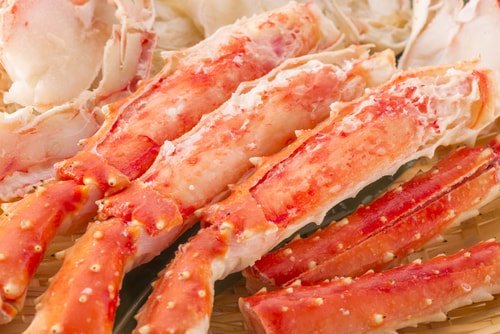
Giant, tender crab legs are delicious and fun to eat. However, imported blue king crab is one of the worst types of seafood.
Imported red and blue king crab tend to come from badly managed fisheries in Russia. U.S. king crab and snow crab are more ecologically raised and have low levels of mercury.
If you love King Crab, opt for the U.S. crabs. Make sure to check your labels!
7. Swordfish
The bigger the fish, the more mercury it tends to have. The Environmental Defense Fund that pregnant women and children never eat this fish.
The FDA has also placed it on their list of fish to avoid for pregnant women and children.
8. Atlantic Bluefin Tuna
If you like sushi, you have probably seen this on the menu.
This large fish has elevated mercury levels, and it is not raised sustainably.
Avoid it and see the bottom of this article for a type of tuna that you CAN eat.
9. Shark
This large predatory fish contains unhealthy levels of mercury.
The Environmental Defense Fund and the FDA are also both in agreement that you should never eat shark.
10. Orange Roughy
This fish has one of the worst eco-ratings because of its poor sustainability. The fish have long lifespans and don’t reproduce in abundance, so the species is suffering from decreasing populations.
Although the meat is white and tender, the large fish usually contains high levels of mercury.
11. Imported Catfish
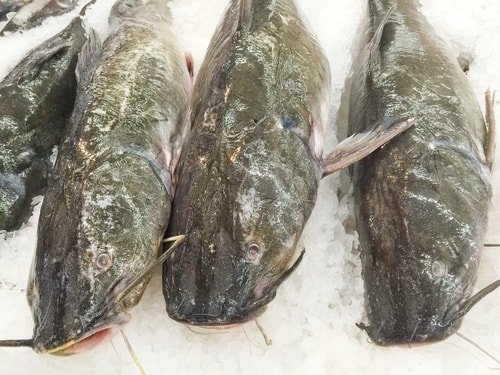
Imported catfish is not the same as domestically grown catfish.
This label is usually placed on pangasius, which has been found to be contaminated with microbes that make you sick (4).
Another case where you just need to make sure that you read your food labels carefully!
12. Eel
Eel is often consumed at sushi restaurants, and the species has become susceptible to overfishing, according to Seafood Watch.
Eels that live in rivers that are affected by toxic dumping (um… Yuck!), like this one in New Jersey, and can pick up unhealthy chemicals that they pass on to consumers.
Last up on the list of fish you should never eat is…
13. Imported Farmed Shrimp
According to NOAA, the average American eats about 4 pounds of shrimp per year. Ninety percent of that shrimp is imported from farms abroad.
These shrimp farms use harmful chemicals like malachite green, a pesticide that is carcinogenic to humans. Science Daily says that a food additive that’s used to maintain the shrimp’s color can cause hormonal problems in men and women.
That’s the second time around that we’re hearing about additives in our food to MAINTAIN COLOR. This is NOT natural.
Aside from the reasons above, shrimp are notorious bottom feeders, meaning that they pick up all of the leftovers (including feces) from other fish.
This Prevention article also provides many good reasons not to eat shrimp.
We recommend to avoid or severely limit them. There are far better options below!
So What Fish Should You Eat?
There are so many types of seafood that you shouldn’t eat that you may wonder how to incorporate omega-3s into a healthy diet.
Number one is by far the most important and the best for you…
Wild Alaskan salmon contains omega-3s and doesn’t suffer from the same detriments as farm-raised salmon.
Wild Alaskan salmon is definitely more expensive than farm-raised, but you can find good deals on it! Fresh is best, but frozen wild Alaskan salmon is FAR better than fresh farm-raised salmon!
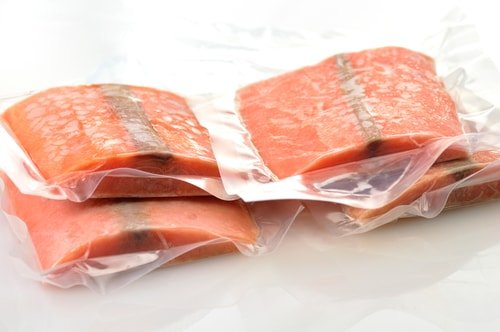
Trader Joe’s has a great price on it in their freezer section, but check out the frozen section of your local grocery store if you don’t have a Trader Joe’s!
If you can’t get salmon into your diet at least once or twice a week, you should consider a good Omega-3 supplement!
Anchovies are high in calcium and low in mercury. Plus, they are high in omega-3s.
You can add anchovies to many recipes to add flavor without fishiness. They blend up well in Caesar salad dressing or can be tossed with the brown bits in a pan, mustard and broth to make a savory sauce.
P.S. Anchovies are in almost ALL Caesar dressings, you just don’t notice it! 😉
Albacore tuna from the U.S. and Canada is the type of fish that you find in cans of white tuna. This fish contains high levels of omega-3s.
While it also contains moderate levels of mercury, the Environmental Defense Fund says that it’s okay for adults to eat it four times a month.
This can be a good source if you’re on the go and need a quick protein pick-me-up.
Bottom line… Be very selective with your fish choices, and ALWAYS read labels!
Please feel free to leave a comment below if you enjoyed this article on fish you should never eat or if you have any questions!

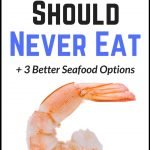
No wonder I dislike most of the fish you mention some has no taste at all the others don’t know what to say taste like card board